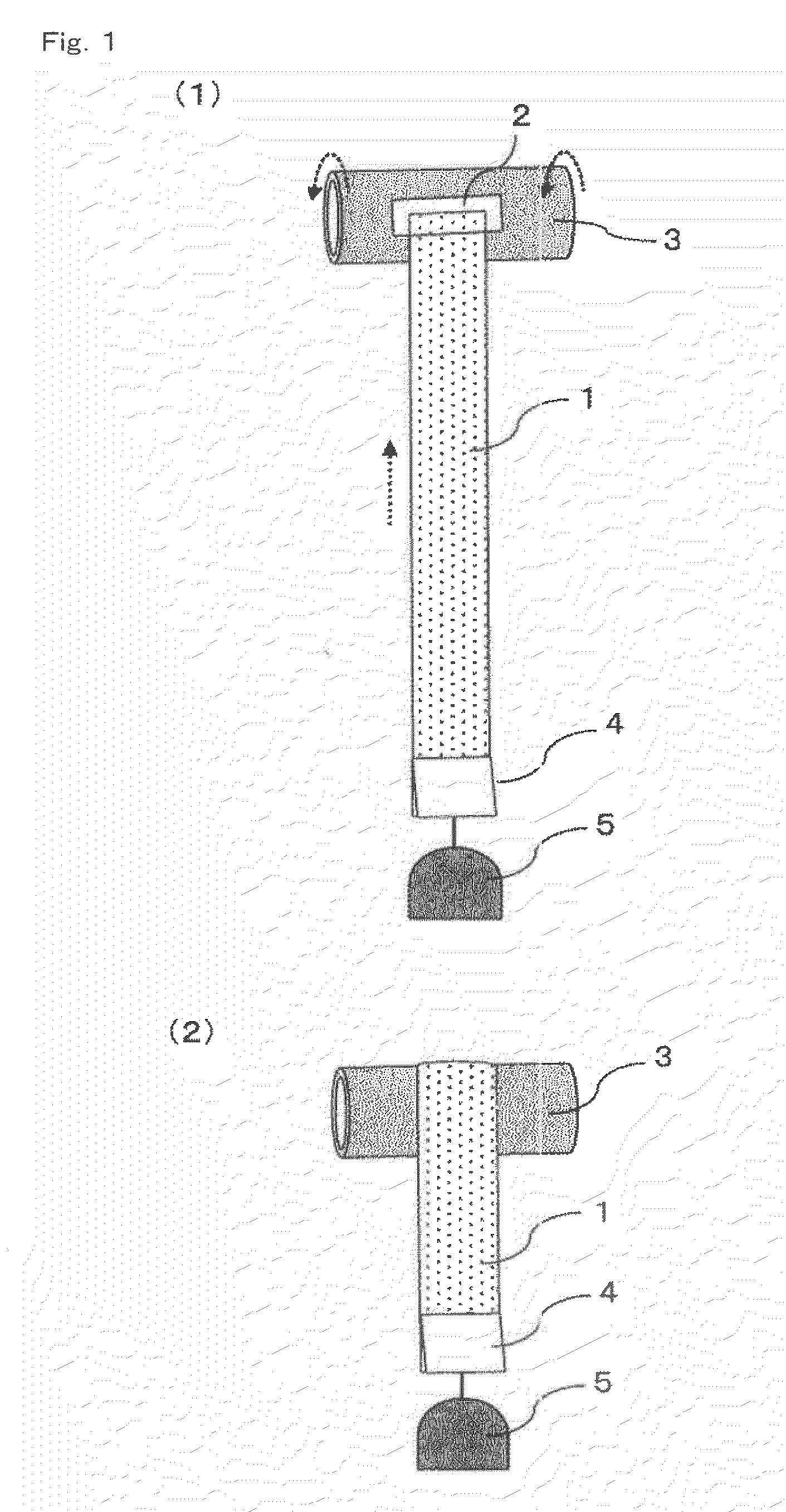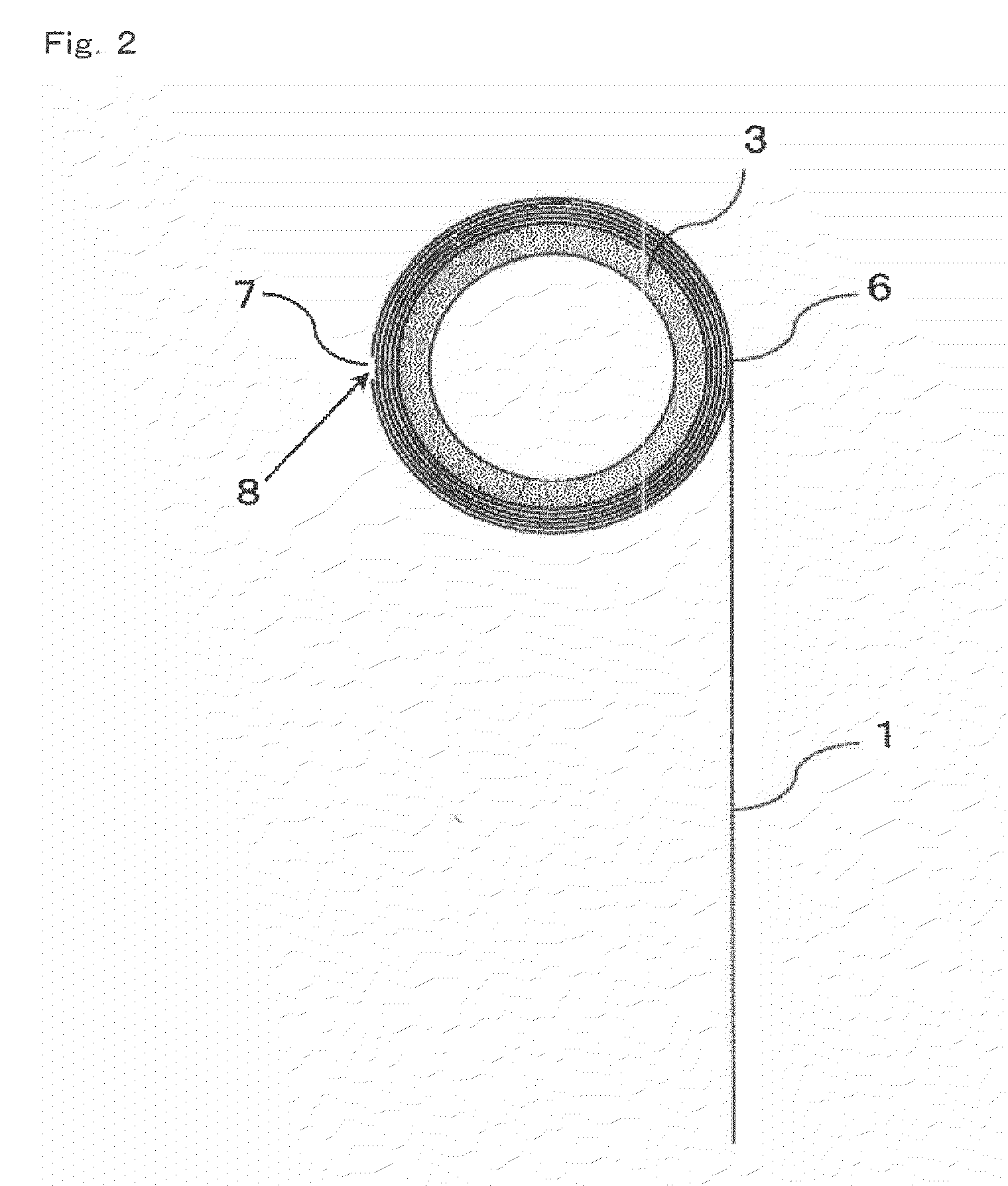Stretchable nonwoven fabric and tape
- Summary
- Abstract
- Description
- Claims
- Application Information
AI Technical Summary
Benefits of technology
Problems solved by technology
Method used
Image
Examples
example 1
[0138]A side-by-side form conjugated staple fiber (manufactured by Kuraray Co., Ltd., “PN-780”, 1.7 dtex×51 mm in length, the number of mechanical crimps was 12 / 25 mm, and the number of crimps was 62 / 25 mm after a heat treatment at 130° C. for 1 minute) was prepared as a potential crimping fiber. The conjugated fiber comprised a polyethylene terephthalate resin (A component) having an intrinsic viscosity of 0.65 and a modified polyethylene terephthalate resin (B component). The B component had been obtained by copolymerizing a polyethylene terephthalate resin the same as the A component with 20 mol % of isophthalic acid and 5 mol % of diethylene glycol. Using 100% by mass of the side-by-side form conjugated staple fiber, a card web having a basic weight of 32.1 g / m2 was produced by a carding.
[0139]The resulting card web was transferred, being on the conveyor net, to pass through a clearance between the conveyor net and a porous plate drum having pores (circular form) having a diamet...
example 2
[0144]Except for a water pressure of 1.2 MPa at which a water flow was ejected to the card web used in Example 1 when passing through the clearance between the porous plate drum and the net as in Example 1, a nonwoven fabric was obtained by the same manner as in Example 1. The obtained nonwoven fabric has a basic weight of 68.3g / m2. The nonwoven fabric also had a high stretchability in the machine direction (MD) and cross direction (CD), respectively. The nonwoven fabric was stretched by hand but was not torn, and right after releasing the stress, the deformed nonwoven fabric restored its original form. The results are shown in Table 1. The nonwoven fabric was slit in a width of 5 cm in the length direction. The resulting nonwoven fabric was rolled up to produce a bandage of the present invention. After wrapping the obtained bandage around a finger about three times, the bandage was strongly stretched by hand at the place to be torn. The bandage was torn. The bandage end produced by...
example 3
[0146]Ninety-five percent by mass of the side-by-side from conjugated staple fiber used in Example 1 and 5% by mass of a polyethylene terephthalate fiber (1.6 dtex×51 mm in length, the number of mechanical crimps was 15 / 25 mm) were blended. The obtained blend of the fibers was subjected to a carding to produce a card web. The obtained card web had a basic weight of 34.3 g / m2. Except that the web was overfed at a rate of about 120% when being transferred to the belt conveyor, the web was processed by the same manner as in Example 1 to produce a nonwoven fabric.
[0147]The obtained nonwoven fabric had a basic weight of 62. 7 g / m2, which had been increased by contraction. The nonwoven fabric had a high stretchability in the machine direction (MD) and cross direction (CD), respectively. The nonwoven fabric was stretched by hand but was not torn, and right after releasing the stress, the deformed nonwoven fabric restored its original form. The results are shown in Table 1. The nonwoven fab...
PUM
| Property | Measurement | Unit |
|---|---|---|
| Fraction | aaaaa | aaaaa |
| Fraction | aaaaa | aaaaa |
| Fraction | aaaaa | aaaaa |
Abstract
Description
Claims
Application Information
 Login to View More
Login to View More - R&D
- Intellectual Property
- Life Sciences
- Materials
- Tech Scout
- Unparalleled Data Quality
- Higher Quality Content
- 60% Fewer Hallucinations
Browse by: Latest US Patents, China's latest patents, Technical Efficacy Thesaurus, Application Domain, Technology Topic, Popular Technical Reports.
© 2025 PatSnap. All rights reserved.Legal|Privacy policy|Modern Slavery Act Transparency Statement|Sitemap|About US| Contact US: help@patsnap.com



